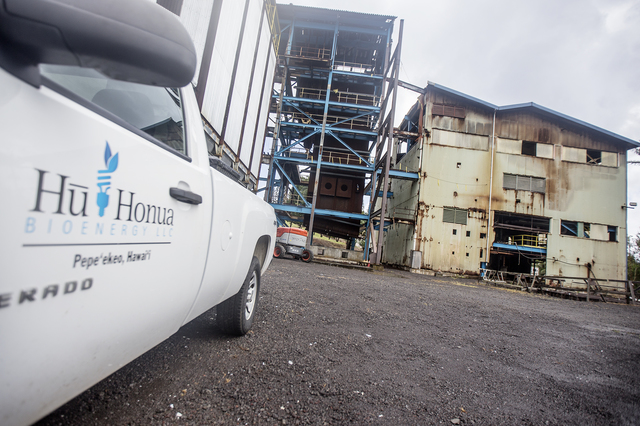HILO — In its latest cost analysis submitted to state regulators, Hawaii Electric Light Co. says Hu Honua Bioenergy would save customers cash in the long run. ADVERTISING HILO — In its latest cost analysis submitted to state regulators, Hawaii
HILO — In its latest cost analysis submitted to state regulators, Hawaii Electric Light Co. says Hu Honua Bioenergy would save customers cash in the long run.
That’s assuming the Hamakua Energy Partners facility, which HELCO recently failed to acquire, closes in 2030 at the end of its contract.
Under that scenario, Hu Honua would provide a net savings of $1.21 per month over the life of the 30-year contract for a customer using 500 kilowatt-hours. With HEP, a fossil fuel plant, still running through 2045, the bioenergy facility near Pepeekeo would on average add $2.43 to bills, according to HELCO’s revised figures.
Hu Honua and HELCO are awaiting a decision from the state Public Utilities Commission after reaching an amended power purchase agreement. That’s the result of a settlement between the parties following the utility — citing missed deadlines — cancelling its contract with Hu Honua in 2016.
The analysis, submitted to the PUC, doesn’t compare Hu Honua with other potential ways to offset the loss of HEP, a 60-megawatt power plant.
“If we had more time, we’d probably do an analysis of Hu Honua as an option versus other options,” said Jay Ignacio, HELCO president. He said the PUC has indicated it’s not interested in extending fossil fuel plants, which could make an extension of HEP’s contract unlikely.
Harold Robinson, president of Island Energy, Hu Honua’s parent company, said their analysis shows customers saving in as little as two years. HELCO doesn’t estimate cost savings occurring until 2030.
“I don’t think HELCO has taken into account all of the benefits” of the project, said Robinson, including savings that could come from the curtailment of additional fossil fuel facilities.
Under the deal, Hu Honua’s “all-in costs” would be 22.1 cents per kilowatt-hour. HELCO would buy a minimum of 10 megawatts.
Hu Honua is being built at a former Hilo Coast Processing Co. mill. It would produce as much as 30 megawatts by burning eucalyptus trees planted on former sugar lands along the Hamakua Coast. About 190 Hawaii Island jobs are projected to be generated.
The state’s consumer advocate said in a filing to the PUC on Monday that he could not come to a final decision on the proposed deal due to “insufficient and inconsistent information.”
“The Consumer Advocate takes note of the fact that Hu Honua does represent a firm renewable energy project that intends to rely on locally produced biomass (and/or biofuels), which could provide benefits for the island of Hawaii agricultural industry,” says the statement signed by Dean Nishina, executive director of the Division of Consumer Advocacy. “There are, however, remaining questions about whether the benefits have been adequately supported to assess whether verifiable benefits might exceed the costs.”
Hu Honua has asked for the PUC to approve “preferential rates” for the project because it would create agriculture jobs. But that might be unnecessary after HELCO’s most recent cost analysis, project officials said.
Hu Honua is under a tight timeline. John Komeiji, a member of the project’s advisory committee, said the project needs an answer by the end of the month to finish construction by 2019.
If not completed by then, it would not qualify for a crucial tax credit that makes the project feasible, he said.
“If this doesn’t get approved by the end of July we have some hard decisions we have to make,” Komeiji said.
Still, investors are committed to the project, according to project officials, though they declined to name a new major financial contributor. The plant could cost as much as $250 million.
Robinson said they have contracts for a third of the feedstock they would need. He estimates it would replant 2,000 acres of trees a year.
Email Tom Callis at tcallis@hawaiitribune-herald.com.





